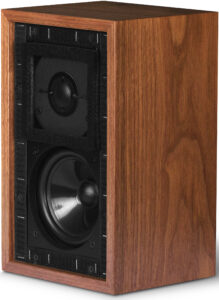
The old Rogers BBC LS 3/5a mini-monitor of the seventies was considered one of the most accurate transducers of its time. The original Rogers factory tried to keep up with latest audio trends in the following decades and at one time even revised the LS 3/5a crossover network to facilitate a lower impedance crossover network that also allowed for bi-wiring. But demand for the original 15-ohm design in the used marketplace was robust and has persisted ever since. This speaks volumes to the legitimacy and performance of the original design as pursued by the audiophile consumer.
Mini-monitors bring excitement for their space-saving aspect and some models’ propensity to play loud without notable distortion. There exist dozens of bookshelf speaker models from notable brands with exorbitant prices and performance claims. Bearing in mind that there is only so much a small radiating area from a mini-monitor can do will quickly separate the ones with solid performance and value from the rest. Headphone listening is the default solution for readers with limited space and I have been auditioning quite a few, but if you want the soundstage to be in front of you, speakers are the only solution.
Per Andy Whittle, chief engineer of the reborn Rogers, production of the original LS 3/5a was suspended in 1999 due to the Asian financial crisis. In 2018, a Hong Kong audio group funded the reopening of the company, and production resumed with Andy at the helm. Per Andy:
“We have gone to great efforts to make the new Classic as close as possible to the original BBC 15 Ohm version. Everything is made under license from the BBC. The cabinet is made here in UK and 100% to the original BBC specifications. We make the cabinet here in UK same as the original Rogers LS3/5a cabinet from the beginning, e.g. highest quality 12mm Russian birch plywood.
Balance veneered, hardwood beech batons for fixing the baffle to and bracing the cabinet. Damping sheet to damp the panels and lined with acoustic foam. The front baffle is made from 9mm Russian birch plywood and stained black. The baffle is fixed to the cabinet with wood screws and the grille cloth material is the correct BBC specified TYGAN…acoustically transparent and much better sounding than normal grille cloth material.
For the speaker terminals we have used Multi Contact 4mm sockets from Switzerland and we get these silver plated for optimum sound quality.
The crossover uses the correct laminated type inductors with variable tapping for HF adjustment. Every component on the crossover was critically appraised for the best sound, crossover is 100% made in UK. Drive units were reverse engineered in Asia with Bextrene cone woofer and mylar dome tweeter. Final assembly, hand doping, pair matching and QC are all done in UK. The fit and finish of the new Classic surpasses that of the original gracing it with stature and elegance!
We are now also manufacturing the BBC LS5/9 to the same exacting standards.”
The Rogers tweeter and midrange driver are certainly rather unique, and the cabinet in which they are mounted is of professional grade and high quality in materials and construction.
Auditioning the Rogers LS 3/5a Classic took place in my main listening room, which measures 17.5 feet wide and 24 feet long with a ceiling that rises from 9 feet high at the right wall to 15 feet on the left wall. The Rogers speakers were placed on a pair of $335 Skylan SP-30thirty-inch sand-filled stands, each positioned five feet away from the front wall and two feet away from a side wall. The speakers were spaced eleven feet apart and nine feet away from the listening position, which sat right beneath the apex of an equilateral triangle. I toed the speakers in completely so that I’d also be on the vertical axis of the tweeters. The soundstaging thus obtained had excellent horizontal spread of instruments on stage, so that even slightly off-centered seating would receive a more even spread of the stage.
Each of the mini-monitors was adorned with a pair of 4mm banana receptors for the positive and return run, a perfect match for my Audio Note UK AN-SPx 27-strand 99.99% silver speaker cables with banana connectors. Interconnects were the Audio Note UK 42-strand Sogon and AN-Vx RCAs.
- (Page 1 of 2)
- Next page →





It sounds like you had a great time with them, especially after you got to know them. Hope I have a chance to hear a pair someday
Rogers ls3/5a new classic end of mini monitors
I remember selling these for $500/pr. That’s a lot of inflation.
Does it make sense to have a quite old pair of these speakers cleaned or even reconditioned?
Dear Joe,
Thank you for your comment and readership.
I’d advise contacting the factory on the cost of reconditioning a pair of old LS 3/5a. But be advised that the sound of a new pair of speakers will sound differently from an old pair of the same model where the drivers’ and crossover’s conditions are concerned.
We naturally attach considerable sentimental value on objects, speakers included, and an endearing pair of Rogers LS 3/5a is understandably hard to part with. Still, speaking rationally, a fresh pair will always present a more accurate sound than a very old pair as the drivers and crossover electronics get old and no longer perform even close to the original specifications.
Musical enjoyment is fundamentally personal, and emotional. No need to struggle if you find it hard to part with your old pair. Clean it, recondition it and keep enjoying it.
Sincerely,
Constantine